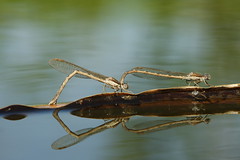My main observation area was a semi-natural park just north of Utrecht (Netherlands) and my aim was not only to get an impression of the abundance of odonata species there, but also to make photos of each species. But I also looked a bit in other places.
Winter Damselfly in February
First thing that happened in 2008 was that I found a some Winter Damselflies (Sympecma fusca) on a location where they get through the winter. I was inspired to search them, when I read messages on a forum by people who had been finding them in relatively dry forest/heather fields. After looking on a map for suitable locations, I was happy to find about 10 adult Winter Damselfies on a sunny February day.
Noorderpark
My main observation area for 2008 was in the Noorderpark (also often called Gagelpolder). I concentrated on the area near the Ruigenhoek Fortress, but sometimes I looked in other parts of the area too. Throughout the year, I counted 25 different species in the Ruigenhoek area and one additional species from another part of the park. Here is the list of species, with some remarks. The date refers to the first sighting.

Sympecma fusca, oviposition

Brachytron pratense

Aeshna isoceles

Libellula quadrimaculata

Anax imperator, female

Crocothemis erythraea, female

Lestes viridis

Sympetrum vulgatum
- Pyrrhosoma nymphula (April 21). Quite a common species in the area.
- Coenagrion pulchellum (April 26). The most abundant species in early spring.
- Sympecma fusca (April 26). The Noorderpark is one of the few known locations near Utrecht where this species reproduces.
- Ischnura elegans (May 2). This species is very common everywhere, no surprise.
- Erythromma najas (May 3). Also common in the area and reproducing. In an area close by, fresh individuals have been observed in late autumn. But I have not seen any late individuals in the Noorderpark.
- Brachytron pratense (May 3). The first anisoptera species at the location. Some exuviae indicated reproduction.
- Libellula quadrimaculata (May 3). The most abundant anisoptera species in spring.
- Cordulia aenea (May 3). Reproduces at the location.
- Libellula depressa (May 10). Although a common species in the Netherlands, I only observed a few at this location. The location does not seem to provide the right habitat for this species.
- Orthetrum cancellatum (May 12). Very common, most abundant anisoptera species in the summer.
- Anax imperator (May 19). Easily recognized, in the summer there are always some around.
- Aeshna isoceles (May 19). Quite common at the location.
- Enallagma cyathigerum (June 2). Appeared quite late at this location, and although common since then even until September, I did not see the large numbers which can be found at other locations.
- Lestes sponsa (June 10). During the year I spotted only a few individuals, but they appeared fresh. Around Utrecht city this species is not very common, but it looks like a small population is present at this location.
- Sympetrum striolatum (June 10). Sometimes hard to tell apart from S. vulgatum. The latter species is very common at the location, but among them there are often one or a few S. striolatum individuals.
- Lestes viridis (June 22). Common species in late summer and early autumn.
- Sympetrum sanguineum (June 22). Always a few of them in summer.
- Aeshna grandis (June 22). Easily recognized. Oviposition observed more than once.
- Crocothemis erythraea (June 23). This species is still rare in the Netherlands although it is expected to become more common due to climate change. On two occasions I saw (and photographed) a female at the location.
- Sympetrum vulgatum (July 4). Most common species at the location in late summer and autumn. It is hard to estimate numbers, but it would not surprise me if would be hundreds.
- Erythromma viridulum (July 14). Enough of them in late summer, oviposition no exception.
- Sympetrum flaveolum (august 3). This year there was an influx of S. flaveolum into the Netherlands. Some individuals ended up in the Noorderpark.
- Aeshna mixta (August 6). Lots of them in late summer.
- Aeshna cyanea (September 9). The only species I did not succeed to photograph at the location.
- Sympetrum danae (September 11). There are some large populations not too far away, and it is not unexpected to have some individuals visit this location.
As I mentioned, there was one more species which I only found in another part of the Noorderpark. That was Aeshna viridis, a rare species in the Netherlands (and even in Europe). I was happy to make this flight photo.
Four of the species above were new on my personal life list for the Netherlands: Crocothemis erythraea, Erythromma viridulum, Sympetrum flaveolum and Aeshna viridis. On other locations I did add some more new species to that list: Leucorrhinia rubicunda, Leucorrhinia dubia, Platycnemis pennipes and Lestes virens. The total length of my species list for the Netherlands is now 34. That is only about half of the species listed for the Netherlands. But although I keep track of the species, I am not much of a species hunter, but concentrate on areas close by.


2 comments:
This photo is magnificent!! I know we are nowhere near each other in location....but this species looks exactly like one around my pond that I've been trying to I.D. Of course, it would help if I had photos that looked like this!!
Wow outstanding image.
Brilliant.
John.
Post a Comment